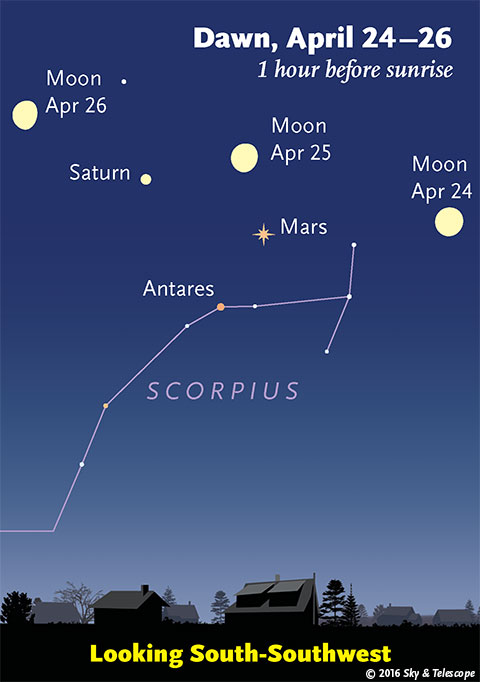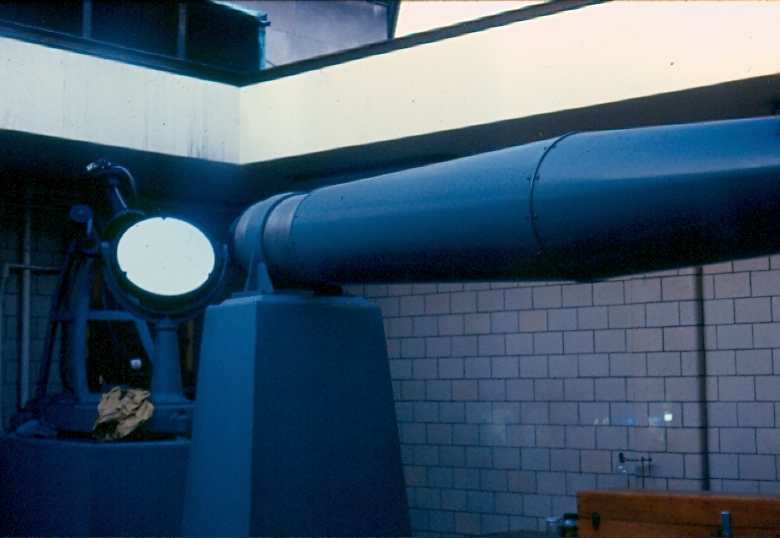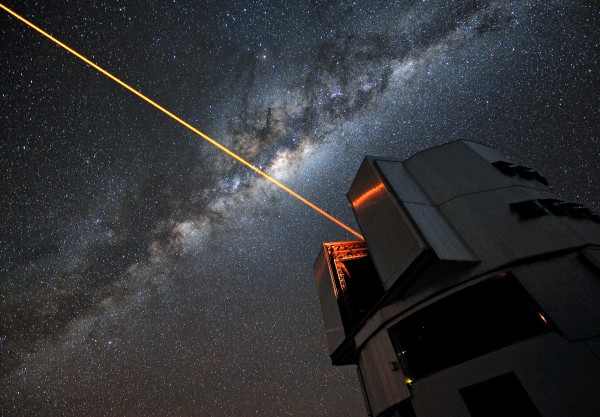
Beautiful celestial grouping before dawn on Monday
and Tuesday (2016 April 25 and 26).
(Graphic Source: Sky and Telescope Magazine)
By Glenn A. Walsh
Reporting for SpaceWatchtower
Monday and Tuesday mornings (2016 April
25 and 26), before dawn, early risers will be able to view a
beautiful quasi-conjunction or celestial grouping of the Moon, two planets (Mars and Saturn), and
the bright Star Antares.
Before dawn on Monday and Tuesday, this
celestial grouping can be found in the south-southwestern sky.
On Monday morning the four objects will
form a sort-of square or diamond with the Moon above the rest. Saturn will be to
the left of the Moon, with Mars below the Moon. The bright Star
Antares, which is dimmer than the two planets, can be found 5 degrees to the
lower left of Mars.
On Tuesday the configuration of the
planets and star remain, pretty-much the same. However, Tuesday
morning the Moon can be found to the upper left of Saturn. Hence, the
Moon, Saturn, and Mars create almost a straight-line, with Antares
still to the lower left of Mars.
The Moon is now in its Waning Gibbous
Phase, having passed Full Moon (the “Pink Moon”) early Friday
morning at 1:24 a.m. Eastern Daylight Saving Time (EDT) / 5:24 Coordinated Universal Time (UTC). As a Waning Gibbous Moon, the Moon now rises very late in
the evening, but is in the sky by local Midnight. So, these celestial
configurations could also be seen earlier in the morning, as well.
Mars is brightening as it grows closer to the Earth. Currently, Mars has a visual magnitude of about -1.3. Mars will be at opposition (when the Earth lies directly between Mars and the Sun) on May 22 at 7:00 a.m. EDT / 11:00 UTC, when Mars will be visible from Earth from approximately local sunset to approximately local sunrise.
Mars will reach its closest point to Earth, for the next two years, on May 30 at 4:00 a.m. EDT / 8:00 UTC, when Mars will have a visual magnitude of -2.1 and a light-speed distance from Earth of 4.2 light-minutes. This will be the closest Mars has been to the Earth since 2005. In two years (July of 2018), Mars will approach about the closest it ever comes to the Earth.
Saturn is somewhat dimmer than Mars at the visual magnitude of +0.3. Like Mars, it rises in the late evening, but about a half-hour later.
Both Mars and Saturn are now in retrograde motion, with Mars having begun the retrograde motion following the Mars movement becoming stationary (from normal motion) on the evening of April 16 at 10:00 p.m. EDT / April 17 at 2:00 UTC. This means that both planets can be seen, from one night to the next, moving from east to west relative to the background stars. When these planets are in normal or prograde motion, they move from west to east relative to the background stars, from one night to the next.
Antares is the brightest star in the
Constellation Scorpius the Scorpion, and hence, the astronomical
designation for Antares is Alpha Scorpii. However, Antares is the dimmest of the four objects with an apparent visual magnitude of +0.96. The Constellation Scorpius will be in
good view below the two planets, until the sky brightens for dawn.
More on the Moon: Link >>> https://en.wikipedia.org/wiki/Moon
More on Mars: Link >>> https://en.wikipedia.org/wiki/Mars
More on Saturn: Link >>> https://en.wikipedia.org/wiki/Saturn
More on Star Antares: Link >>> https://en.wikipedia.org/wiki/Antares
More on Constellation Scorpius: Link >>> https://en.wikipedia.org/wiki/Scorpius
Source: Glenn A. Walsh Reporting for SpaceWatchtower, a project of Friends of the Zeiss.
2016 April 25
May 9 - Safe Public Viewing of Rare Astronomical Event

2016: 75th Year of Pittsburgh's Buhl Planetarium Observatory
Link >>> http://spacewatchtower.blogspot.com/2016/01/astronomical-calendar-2016-january.html
Like This Post? - Please Share!
Want to receive SpaceWatchtower blog posts in your inbox ?
Send request to < spacewatchtower@planetarium.cc >..
gaw
Glenn A. Walsh, Project Director,
Friends of the Zeiss < http://buhlplanetarium.tripod.com/fotz/ >
Electronic Mail - < gawalsh@planetarium.cc >
SpaceWatchtower Blog: < http://spacewatchtower.blogspot.com/ >
Also see: South Hills Backyard Astronomers Blog: < http://shbastronomers.blogspot.com/ >
Barnestormin: Writing, Essays, Pgh. News, & More: < http://www.barnestormin.blogspot.com/ >
About the SpaceWatchtower Editor / Author: < http://buhlplanetarium2.tripod.com/weblog/spacewatchtower/gaw/ >
SPACE & SCIENCE NEWS, ASTRONOMICAL CALENDAR:
< http://buhlplanetarium.tripod.
Twitter: < https://twitter.com/spacewatchtower >
Facebook: < http://www.facebook.com/pages/
Author of History Web Sites on the Internet --
* Buhl Planetarium, Pittsburgh:
< http://www.planetarium.
* Adler Planetarium, Chicago:
< http://adlerplanetarium.
* Astronomer, Educator, Optician John A. Brashear:
< http://johnbrashear.tripod.com >
* Andrew Carnegie & Carnegie Libraries:
< http://www.andrewcarnegie.
* Civil War Museum of Andrew Carnegie Free Library:
< http://garespypost.tripod.com >
* Duquesne Incline cable-car railway, Pittsburgh:
< http://inclinedplane.tripod.
* Public Transit:
< http://andrewcarnegie2.tripod.



